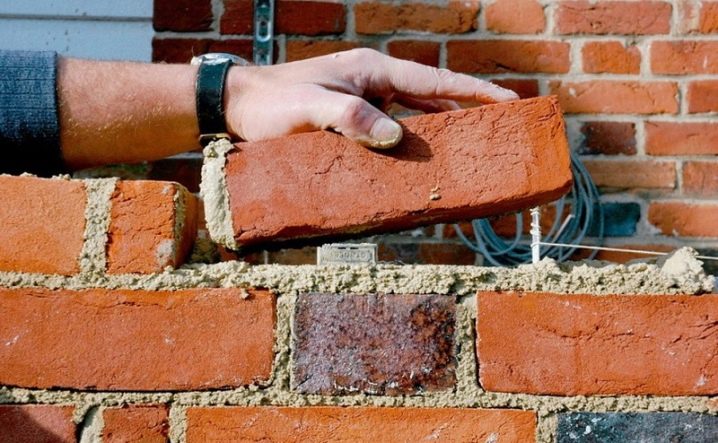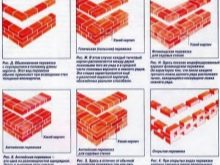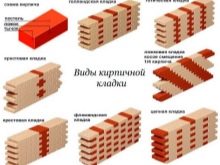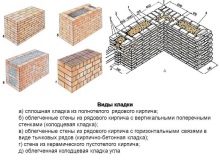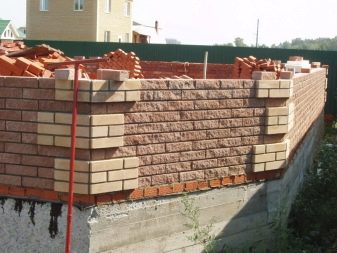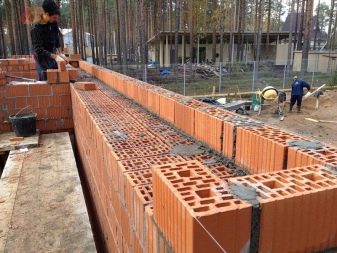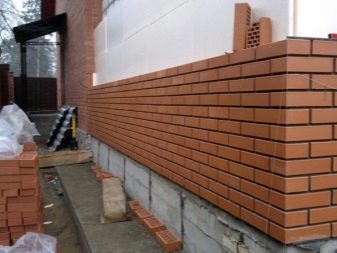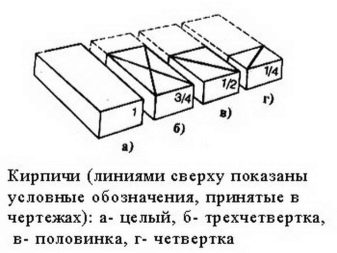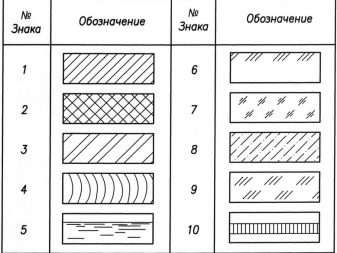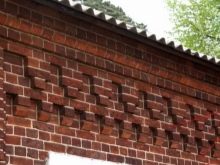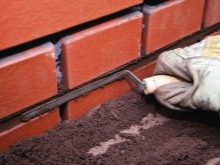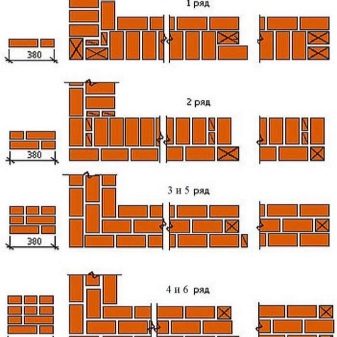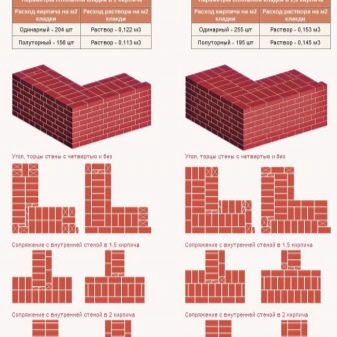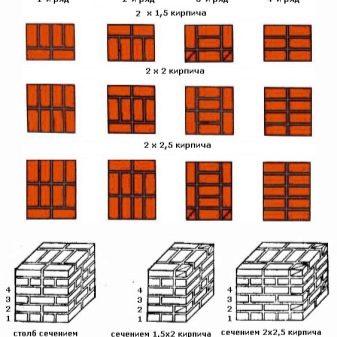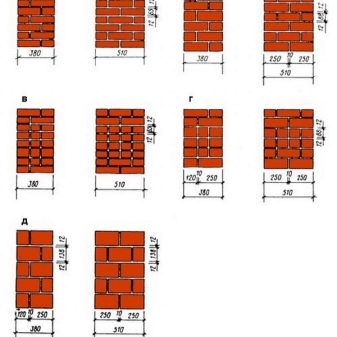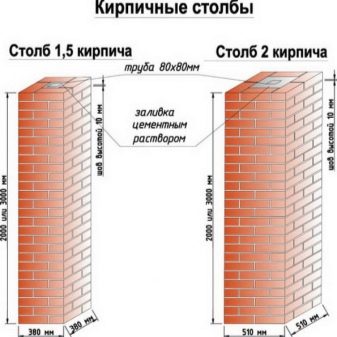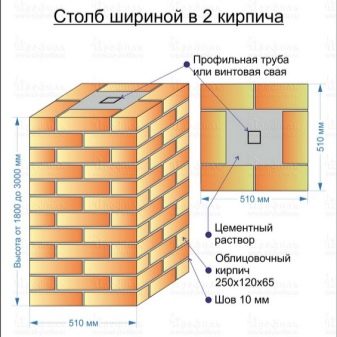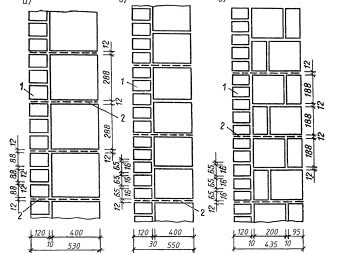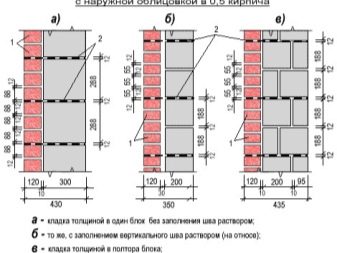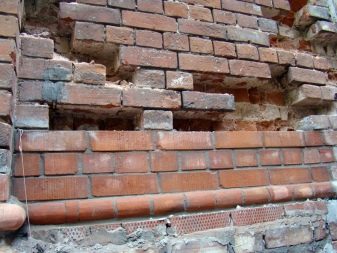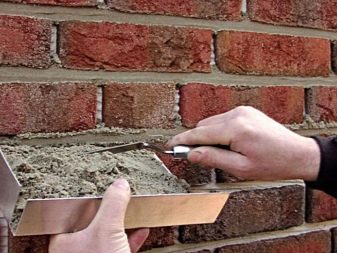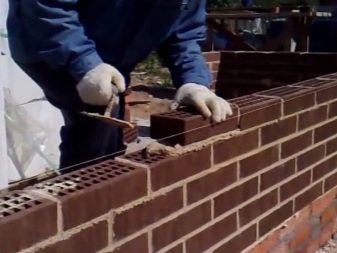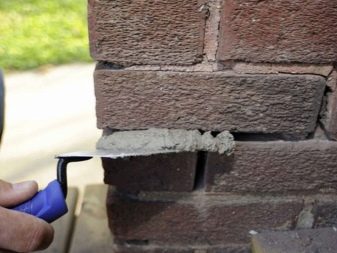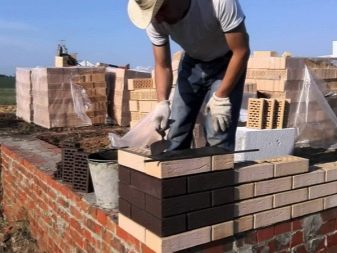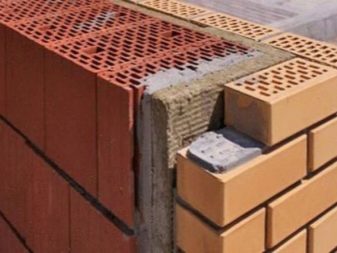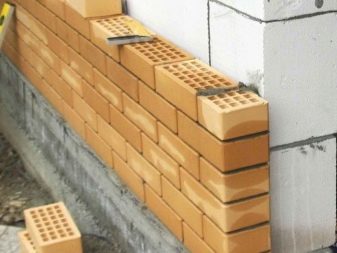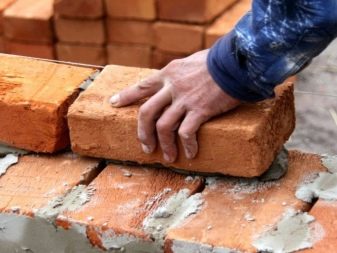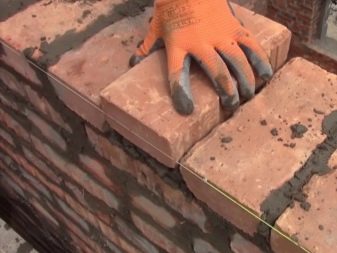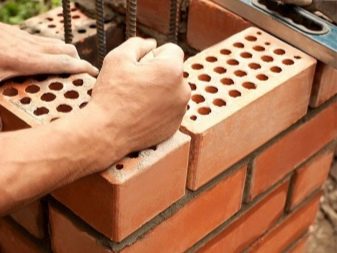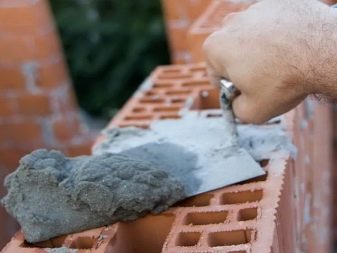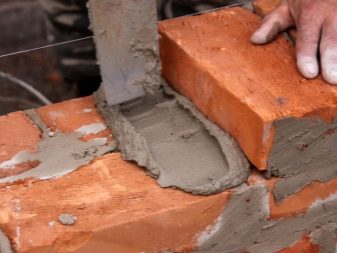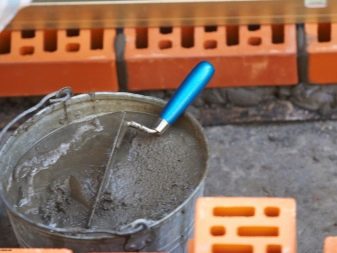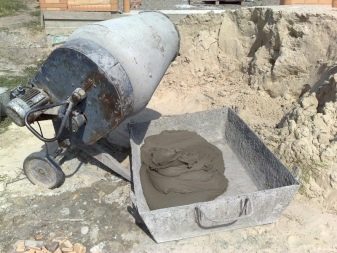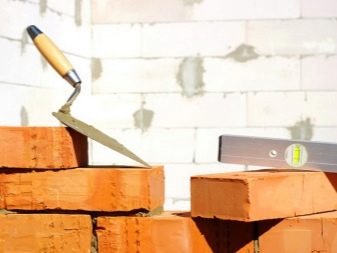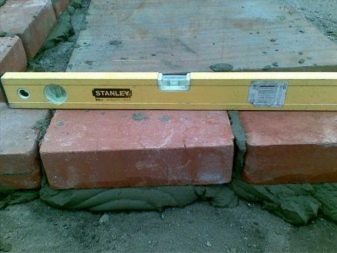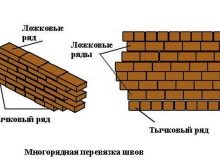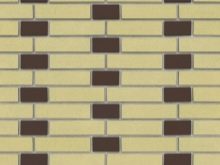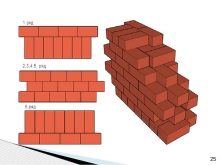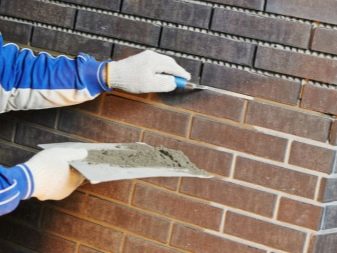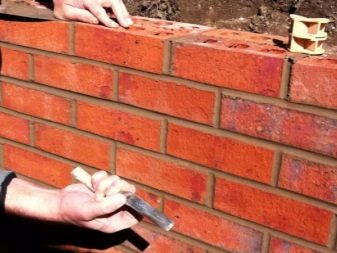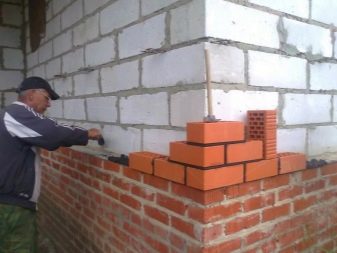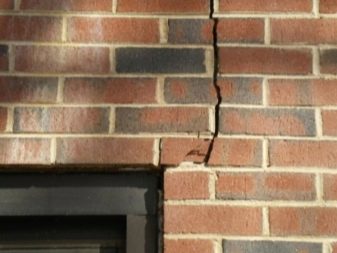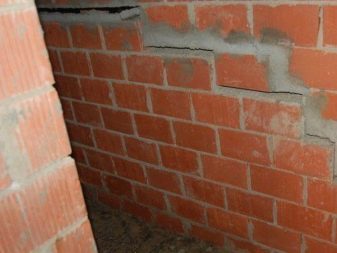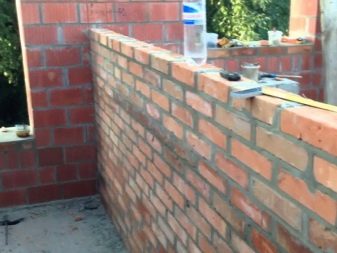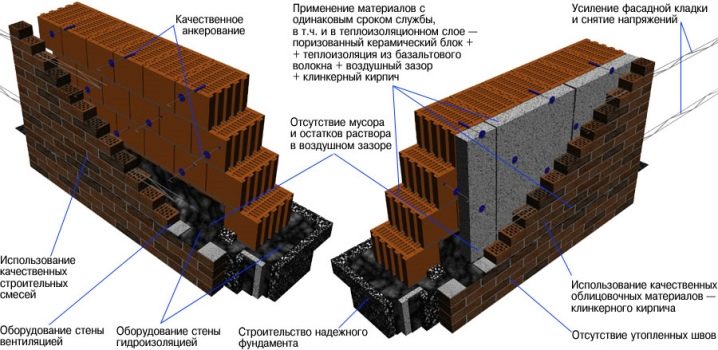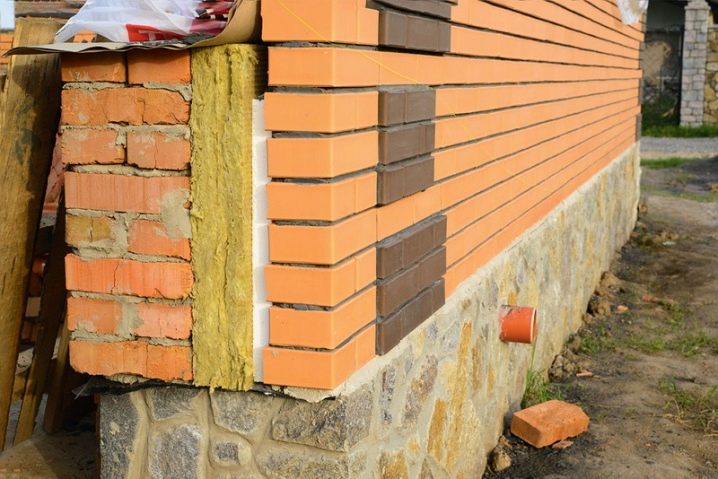Brickwork: methods, sizes and principles
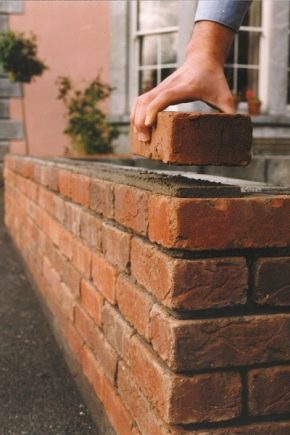
Brickwork is considered to be one of the simplest and at the same time fundamental construction works - today without it it is almost impossible to build this or that building with your own hands. Although the procedure, at first glance, does not require special knowledge and skills, it is unacceptable to treat it carelessly. The quality of its implementation depends on how long the wall will stand and whether it will not be a danger to people inside. For this reason, you should not rely only on your own intelligence, it is desirable, at least in general terms, to get an idea of the task beforehow to start its implementation.
Types and dimensions of bricks
Building material with this name comes from different types of raw materials, and therefore it can have completely different sizes, but we will discard the adobe and other blocks, focusing on the brick in the classical sense - the one that is white and red. Theoretically, it is possible to make blocks of any size to order, however there are standard dimensions, which in the form of a table look like this:
- a simple single brick is 25 cm in length, 12 in width and 6.5 in thickness;
- the thickened version has all the same parameters, except for the thickness, which here is already 8.8 cm - by the way, in the usual horizontal laying it is perceived rather as height;
- a single brick of modular dimensions is slightly larger than simple one in length and width — 28.8 cm and 13.8 cm, respectively, but it is 6.3 cm less in thickness than it is 2 mm;
- thick brick of modular size has a length and width, as in a single modular dimensions, and thickness - as in a simple thickened;
- The thickened version with a horizontal arrangement of voids has dimensions that are completely analogous to a simple thickened one - 25 by 12 by 8.8 cm.
Special features
The correct choice of the main building material is only half the job, because you still need to properly lay it down so that the wall of the house matches the required density and elastic modulus to support the weight of the building, and also has a sufficiently low thermal conductivity so that it is warm even in winter. All of these indicators also need to know in advance to properly design the structure and accurately calculate the number of bricks needed.
Accepted notation
To understand the characteristics of the brickwork, you should first get acquainted with the common notation used among builders to quickly understand what is at stake. First, consider how the various faces of the building block are called. Thus, the flat, long and wide side with a maximum area, which in the horizontal masonry is usually located above and below, is called a bed. The side bounded by the length and thickness, having an average size relative to the other faces of the brick, is called a spoon - that is what we usually see in the finished masonry. The smallest face, in which one block is usually adjacent to another with any type of laying, is called a poke.
As for the laying itself, there are a few more definitions here, but it’s not too difficult to understand them either.
- Stitches - These are the junction points between bricks, which are usually filled with mortar. They are horizontal and vertical - it depends on the spatial orientation of such a seam.
- Bricks rarely put in one rowtherefore it is customary to classify the rows by their location in the wall being erected. If the blocks with one side go inside the future building, such a row is called an internal mile, if it is outside - the front, or external mile. Sometimes a row of bricks is hidden between the outer and inner miles - then it is called zabutkoy.
- Brick bed almost always hidden inside the wall, but to its surface it can go both with a poke and a spoon, respectively, such rows are called tychkovymi or spoon. If on the surface of the wall all the rows look the same, being tychkovymi or spoon, then respectively the whole masonry is called tychkovoy or spoon. At the same time, for increased strength, which is especially important for the outer wall of the house, and sometimes just for beauty,a certain system of ligation of seams is used, when the whole laying cannot be called either a bonder or a spoon, because the rows alternate in it according to a certain pattern. Sometimes, even within a single row, a ligation system is observed to create a pattern on the surface.
For the sake of the convenience of builders, the width of the masonry is measured in halves of bricks - it will simply be inconvenient to divide the blocks into smaller parts.
Thickness and height
The thickness of the brickwork is the distance between the outer sides of the inner and outer mile. Often, it is the thickness that determines the strength of the wall and its ability to retain heat, so this indicator is determined based on the climate of the region, as well as the purpose of the building and its total weight. The thickness of the masonry is usually measured in quarters, halves and whole bricks. If in the thick masonry there are several horizontal rows deep into the walls, then between them there should also be a vertical seam, which also slightly increases the dimensions. On average, it is estimated at 1 cm, but in practice deviations in one direction or the other by 2 mm are quite real and acceptable.
Consequently, the thickness of the masonry can be one of these types.
- A quarter brick - 6.5 cm thick. In fact, no one breaks a brick - it is simply put on a spoon, which is about four times narrower than the length of the bed of a single block.
- Polkirpicha - 12 cm. As in the previous case, nobody crushes building materials - the blocks are simply laid horizontally on the bed, and from the outside and inside of the masonry you can see the spoons.
- Brickwork in one brick - 25 cm. Theoretically, it can be made from two versts with half a brick, but the wall will be more reliable if there is only one layer - just the bricks are laid horizontally on the bed, and outside and inside you can see their pokes, while they lie to each other with spoons.
- One and a half bricks - 38 cm. In this case, we get a combination of the two previous options - one of the miles is laid out on the principle of “one brick”, and the other - “half a brick”. In this type of masonry, a vertical seam is already assumed, so it is included in the calculation of thickness as an additional centimeter.
- Two bricks - 51 cm. Two parallel masonry in one brick plus one vertical seam between them.
- Two and a half bricks - 64 cmIn thickness, two vertical seams are laid at once, surrounding on one side from both sides. One of the miles is laid out in half-brick, while the second is a whole.
The situation is somewhat simpler with the laying height, since laying a quarter brick is rare, which means that only the thickness of the brick is taken into account, which is 6.5 cm for a single brick, and 8.8 cm for a thickened one. the seam, which on average is somewhat thicker than the vertical one, is rounded to 12 mm, although in reality it varies between 10 and 15 mm. If the laying is planned to be improved with reinforcement or electric heating, then the horizontal joint can in principle not be thinner than 12 mm.
Consequently, when using a single brick, the height of one row is on average 7.7 cm (the row itself plus a seam), in the case of the thickened version, this figure is exactly 10 cm. Both versions of the building material have dimensions calculated specifically for get the whole unit of height measurement - one meter. To do this, you need 13 rows of single brick or 10 - thickened.
Physical qualities
The strength of a brick wall depends on very many qualities, some of which directly depend on the quality of the masonry. The properties of brick and mortar also have a certain value, but with them the situation is somewhat simpler. The compressive strength of masonry as a whole is approximately twice as low as that of a single brick used in its construction. The fact is that in the finished wall it is almost impossible to achieve perfect uniformity of the load on the entire area, because neither the blocks themselves are perfectly flat, nor the structure of the solution in the joints is stable and the same. A classic brick perfectly withstands compression, but its flexural strength is much lower — on average, fivefold; therefore, it is important not so much to reduce the weight of a structure as to have its proper distribution.
Most often, the destruction of the masonry begins with the fact that the brick, whose middle is located exactly under the vertical seam of the next horizontal row, cracks in half, because here it is experiencing simultaneous stress in compression and bending. Due to the lack of an adequate connection between the two halves, the load on the adjacent bricks from above and below additionally increases, due to which a vertical crack begins to grow.Over time, the signs of discord are only getting worse, and as a result, the wall collapses.
The choice of a thickened brick can partly prevent this, since in the walls of such material there are predictably less vertical joints, which are a weak point of masonry. The block itself, from increasing its thickness, also becomes stronger and is able to withstand increased load. It is advisable to choose more and the material is perfectly correct form. This allows you to evenly distribute the load and simply simplify the ligation, because the individual elements are ideally suited to each other.
The properties of the solution also have a certain effect on strength. The higher the mark, the better the mass seizes and resists compression, but it is better to pay attention not even to the mark, but to the plasticity of the composition. Only thanks to the last indicator, the solution is evenly distributed along the seam, and this will reduce the unevenness of the load on certain parts of the masonry.
Contrary to popular belief that the bricklayer is a profession that requires more physical effort, the quality of work is also of paramount importance.Walling requires a certain talent and slowness in favor of quality, because the seams must be tightly filled with mortar at the same density and thickness. Once an experiment was even made, according to the results of which the wall erected by an experienced craftsman turned out to be almost twice as strong as a completely similar in material and thickness but built by a beginner.
Brick masonry is valued for its remarkable durability, as well as its ability to withstand fire and the effects of chemicals. All these indicators are due to the density of the blocks, but many designers in our climate prefer to choose building materials of lesser density, since such bricks have a much lower thermal conductivity. In addition, with the use of materials of lower density, the weight of the structure is also reduced, and this also saves the bricks themselves and the foundation, while also saving on construction. On average, a double decrease in the density of the blocks gives almost the same reduction in the mass of the structure (the solution does not change its mass) and a one-and-a-half saving on materials, which is possible due to a decrease in pressure on the lower part of the building.
Necessary tools and solution
The solution as a whole has already been mentioned above - it must be plastic and as strong as possible so as not to be a weak link in the masonry. As for the setting time of the composition, the time here should be the larger, the less experience the master has, since beginners are often not able to work quickly. If there is no experience at all, the freezing time should be no less than three hours.
The solution can be purchased already in finished form, then it will probably contain various additives, in particular, increasing the resistance of the mixture to frost. However, many owners who prefer to build independently, make the solution themselves. Keep in mind that different grades of cement, providing different degrees of strength of the mixture, suggest different proportions for mixing with sand, because there is no universal formula for the calculation.
Masonry is not done with bare hands - before starting work, you must stock up with the appropriate tools. A set of all the necessary may have the following form.
- Trowel, also known as trowel - the main tool of any bricklayer, strongly associated with it, looks like a characteristic triangular blade.It is necessary to perform several tasks at once - for example, applying a mortar, leveling it and making grooves.
- Pick hammer allows you to split bricks, because the dimensions of the planned wall are unlikely to fit the size of the block everywhere. In addition, using such a tool you can deal with the irregularities of the brick. For cutting an alternative tool can be a grinder with a diamond disc, then it also needs appropriate devices like protection for hands and face.
- In order for the masonry to be even and not squinted under the influence of the elementary laws of physics, in the process of building walls it is necessary to use level, plumb and reliable cord.
- Concrete mixer will stretch the freshness of the solution in time, but can be an expensive acquisition if you do not plan to engage in construction regularly.
- Corners and crossbars will be good helpers in terms of complicating the geometry of the masonry, when not a single wall without frills is erected, but a complex structure with corners, as well as window and door openings.
Sewing systems and types
Although the bricks are about the same size,they are always laid with a certain overlay on the next row - this is called bandaging and contributes to the formation of a complete wall instead of a set of brick columns interconnected only by mortar. There are quite a few ways to organize dressing, but three of them are most popular today.
- Chain method, also known as single row, is probably the most successful because it is both quite simple and very reliable. The point is that the individual horizontal rows are laid out and poked, and spoon, and usually through one - a kind of "interweaving" is obtained. The result on the front side is quite beautiful, because the exterior finish is optional. For the correct design of the corners and any other cuts, you will need pieces in a quarter, three quarters and a half-brick, because without them finishing the wall in the right place with a competent cut will be problematic. It is better not to do this cutting yourself - there are manufacturers who produce blocks of appropriate sizes.
- Chain dressing especially relevant at the intersection of two walls.Each second row in this case is partially embedded in another wall, due to which the two sides of the building are characterized by integrity and each of them rests on the next. This adds strength to the building and increases its durability.
- Multi-ligation lies in the technique of laying, in which the spoon and butched rows go not through one, but in any other order and in an unequal number — the rows of one of the species will be much more than the other. At the same time, a slight displacement of the next row with respect to the similar one is always preserved.
A good example of how complex dressing systems increase the strength of a building is some of the old buildings that are found all over the world. In ancient times, the solution was not known to many nations, moreover, it is justly considered less reliable than a brick, however, seamless masonry with competent ligation sometimes even amounts to several millennia, and is not particularly affected.
Rules and Layout Options
The correct layout necessarily assumes some shift of the next row relative to the previous one.If for the walls, which in the future also imply an aesthetic finish, the layout doesn’t matter much, in some cases the customer may ask to lay out a specific pattern or even a pattern of bricks, butt or spoon unfurled in a certain order - then the additional design is no longer will need. Therefore, the layout is useful for the strength of the building, and for its attractiveness.
Again, you can come up with many layouts, even putting out quite recognizable contours, but Today, six schemes that are characterized by relative simplicity are very popular.
- "Track" - The simplest scheme that children learn while playing with the designer. Laying one brick on the other is exactly half its length, making up a smooth and simple pattern. Accordingly, the parts are smaller than half a brick, in this case they are not needed.
- Block layout involves a deliberate alternation of whole bricks and halves in the same row, but not necessarily through one. The offset here is usually relatively small, because the wall looks like smooth, vertical zigzags of the same shape.
- Cross model it is also based on the alternation of whole bricks and halves, but the point is that the horizontal rows go through one, looking like spoon and butting (these can simply be laid out from the halves, if the wall is thin). The aestheticism of the calculation consists in the fact that half of the whole brick is laid on top of the whole brick, due to which a characteristic cross pattern is obtained.
- In the Brandenburg model In each horizontal row, the calculation is carried out according to the principle “behind two whole bricks the third is half”. The displacement is done in such a way that the middle of this half is located exactly below (and above) the vertical seam between two whole blocks.
- Gothic masonry It makes it possible to use constantly alternating blocks of different lengths, but a certain pattern must be traced due to a uniform displacement of identical rows.
- Layout "savage" requires the observance of a single rule - bricks of different lengths are arranged chaotically, they do not necessarily have to look through logic.
Common mistakes
Huge construction costs will not pay off at all if the owner himself is not very well versed in masonry techniques or has hired performers who are not seeking to do the job efficiently. There are a lot of mistakes that spoil the final result, because they definitely need to be mentioned.
- Careless attitude to work is unacceptable. The masonry, like the seams, must be strictly flat, the latter must be diligently filled with a solution in the same quantity. If this is not done, there will be gaps in the wall that do not contribute to heat saving, and the wear of the wall is likely to accelerate.
- It is undesirable to lay bricks obliquely, and if this is done, then at least there should not be significant voids filled with only mortar - the brick should always rest on another brick or its piece. Such an error is often made with a sloping roof, and the likely result is a collapse of the whole structure, because the solution is much worse than a brick withstanding compression, and the blocks themselves will not bend over a nonexistent support.
- A poor-quality brick with a large amount of lime is subject to mandatory finishing, otherwise in wet weather it will gradually fall out of the blocks, creating voids and threatening the building collapse.
- Too thin walls or neglect of the creation of a ventilation gap between the insulation and the facing mile result in condensate that can accumulate inside the wall, which freezes in winter.As you know, water expands when it freezes and requires more volume, which can break the wall.
- The use of hollow bricks is assumed exclusively in the wall, and the holes in it should not be visible from the outside. Even if you later seal them with a solution, it still does not save the room from significant heat loss through these holes. In addition, moisture, getting here, can freeze with all the ensuing consequences described above.
- Above any openings in the wall should be installed solid solid lintels capable of supporting the weight of the entire brick above them. Such a construction should go deep for a good 15-25 cm into the wall on each side of the opening, otherwise its collapse is only a matter of time. The width of the embedding on both sides should be the same. It is unacceptable to rely on the fact that a large recess on the one hand eliminates the insufficient on the other.
Building tips
Skilled masters almost always can give some useful tips for beginners, without which they would surely make one of the common mistakes. For example, the fundamental point is the correct calculation of the foundation, taking into account the hydrogeology of the selected territory.It should be understood where the groundwater is located, how much of it, how much ordinary rainfall influences their amount, whether the soil is equally stable under the future house during the year. If this is not taken into account, even a correctly calculated foundation, which supposedly has sufficient strength, can “float”, especially if it is also made of brick and has limited bending strength. In such a situation, it only contributes to the stretching of the walls above it and the bending of individual blocks, because the cracks in the walls will appear too quickly and the building will not survive for long, representing a real threat to its inhabitants.
A separate point is the warming of the exterior walls of the house or lining the main wall with facing materials. Many newcomers do not take into account that there is a need to leave a small gap between these two layers, because when temperature drops, there will always be condensation that can destroy the structure. If moisture gets inside, a fungus can also penetrate there, which over time destroys the structure of building materials and increases the wear and tear of the house.
To avoid such phenomena, it is necessary to properly organize the ventilation of the inter-wall space, for which special ventilation boxes are used. Such a device is made of very durable materials that can normally transfer any humidity and temperature drops without deformation. Thanks to them, thermoregulation inside the wall occurs naturally, and the excess moisture gets an outlet, therefore it does not accumulate inside and does not destroy the structure so much.
How to make a brickwork with your own hands, see the next video.
